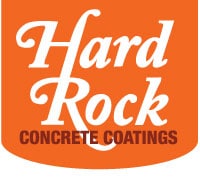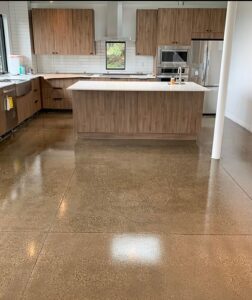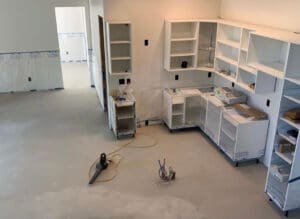Concrete floors used to be an anomaly among indoor flooring options, but now they’re gaining traction because they’re customizable and durable. If you want to stand out from your neighbors or you’ve grown tired of the same old carpet, linoleum, tile, wood, stone, or marble flooring, then concrete floors are a new option to consider. Countless color options, textures, patterns, and finish options call for endless design possibilities.
Traditionally, indoor concrete flooring was exclusively restricted to garage and basement floors only, but it’s now become a popular contender for kitchen, bathroom, and foyer floors. Although concrete is long-lasting, there will be a time when you’ll have to either patch or reseal your floor. Granted, this won’t occur until your concrete floors are a few years old, but it’s better to be prepared for when that time comes. Here are a few ways to repair your indoor concrete floors.
The Right Time to Repair Concrete Floors
When you begin to notice your slabs have grown cracks and other unsightly cosmetic flaws, you can quickly repair your concrete flooring with a surface topping. Each concrete reparation method involves covering an existing piece of concrete with a new coating of concrete. The following three methods can be used for both internal and external concrete floors.
Micro-Topping Treatments
One of the ways you can restore your cracked concrete is by using a micro-topping treatment. Micro-topping treatments are no thicker than 1/8 inch and are made with fragile layers of polymer-modified concrete. Depending on the desired look you want for your flooring, apply polymer-modified concrete, which contains sand, using either a towel or brush.
One of the main benefits of trying micro-topping restoration is that these toppings dry quickly. Treated surfaces dry within 1-2 days, and you’ll be able to walk on your floor once the concrete is dry. Remember to seal your micro-topping finish, as it will be porous and might collect dirt that will be difficult to remove.
Self-Leveling Treatments
Self-leveling treatments are versatile and can be applied to almost any concrete surface. Treatments are thick enough to help correct crooked, uneven surfaces, and they can aid deep surface damage. Homeowners love going with self-leveling concrete treatments because they have the liberty of coloring this concrete with tints during the initial mixing process. Don’t worry if you forget to tint your concrete, as you can always go back and paint it with special concrete dye once it’s applied and cured. Best of all, self-leveling concrete results in solid and durable concrete floors.
Stamped Concrete Treatments
Stamped concrete surface treatments have existed for decades, but they’ve only recently become popular as a treatment option for indoor concrete floors. What makes stamped concrete treatments stand out is the fact that they’re fully customizable. This type of concrete is stamped with a tool to replicate the appearance of tiles, natural stones, or bricks. A coat of concrete sealer should be applied to your stamped concrete once you create a pattern.
If you don’t want to deal with the hassles that come with repairing concrete, you’ll need to enlist the help of a professional. Hard Rock Concrete Coatings boasts years of experience in repairing and fixing concrete mishaps. Contact Hard Rock Concrete Coatings today.



